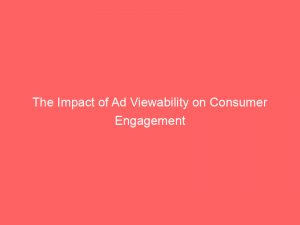- viewability
- Current Industry Standards For Viewability Measurement
- Definition Of Viewability For Ads
- Viewability Measurements For Video Ads
- Viewability Measurements For Desktop Ads
- Challenges With Measuring Viewability For Custom Ad Units
- Lack Of Viewability For Display Ads According To Active View Data
- Efforts To Develop A Standard For Measuring Viewable Impressions
- Benefits Of Viewability For Advertisers And Publishers
In the vast digital realm of advertising, where attention is fleeting and competition is fierce, the notion of viewability has become paramount. Picture this: brands invest exorbitant sums to get their messages across, but what if those messages go unseen?
What if, amidst the chaotic landscape of online content consumption, ads get lost in the shuffle? Such inefficiencies have plagued the industry for years.
While the concept of viewability aims to measure if ads were actually seen by users, a consistent standard has yet to be established. However, hope is not lost.
Enter Google’s Active View technology, which promises a solution to this quandary. But be warned, the battle for improving viewability is far from over.
Join us as we explore the evolving landscape of viewability and the ongoing efforts to establish a standard that truly maximizes ad exposure.
| Item | Details |
|---|---|
| Topic | The Impact of Ad Viewability on Consumer Engagement |
| Category | Ads |
| Key takeaway | In the vast digital realm of advertising, where attention is fleeting and competition is fierce, the notion of viewability has become paramount. |
| Last updated | December 27, 2025 |
viewability
Viewability is a measure of whether or not an ad had a chance to be seen by a user. Currently, industry standards for viewability measurement are still evolving and not fully adopted.
An ad is considered viewable when 50% of pixels are in view for at least one second, while video ads require two seconds of viewability. Desktop ads require 30% of pixels to be in view.
Custom ad units do not have a consistent standard for viewability measurement. Google’s Active View technology is a solution for measuring and buying viewable impressions.
The industry is working on developing a standard for measuring viewable impressions, and the Media Ratings Council has lifted its advisory on transacting viewable impressions as a digital advertising currency. Google supports the IAB and MRC definition of viewability for display advertising.
Viewability allows advertisers to measure campaign effectiveness and determine high-value inventory. It also allows publishers to optimize their site’s ad experience by maximizing viewable inventory.
Moreover, viewability limits oversupply of digital ads and refocuses digital advertising by guaranteeing messages are displayed in front of prospective customers. Google’s Active View is an example of how viewability is implemented.Key Points:
- Viewability is a measure of whether or not an ad had a chance to be seen by a user.
- Industry standards for viewability measurement are still evolving and not fully adopted.
- An ad is viewable when 50% of pixels are in view for at least one second, video ads require two seconds of viewability, and desktop ads require 30% of pixels to be in view.
- Custom ad units do not have a consistent standard for viewability measurement.
- Google’s Active View technology is a solution for measuring and buying viewable impressions.
- Viewability allows advertisers to measure campaign effectiveness, optimize inventory, and focus digital advertising on prospective customers.
Sources
https://advertising.amazon.com/library/guides/viewability
https://www.thinkwithgoogle.com/marketing-strategies/video/see-how-viewability-is-measured/
https://www.thinkwithgoogle.com/marketing-strategies/data-and-measurement/viewability/
https://www.digitalmediametrics.com/brand/viewability
Check this out:
💡 Pro Tips:
1. Advertisers should prioritize video ads as they require two seconds of viewability, compared to one second for other ad formats.
2. Custom ad units need to be assessed individually for viewability measurement as they do not have a consistent standard.
3. The lack of industry standards for viewability measurement means that advertisers need to stay up to date with the current developments and guidelines.
4. Viewability metrics can help advertisers optimize their ad campaigns by identifying low-viewability inventory and reallocating budget to high-viewability placements.
5. Implementing technologies like Google’s Active View can provide a reliable solution for measuring and buying viewable impressions.
Current Industry Standards For Viewability Measurement
Viewability is a crucial metric in the digital advertising landscape. It measures whether or not an ad had a chance to be seen by a user.
However, the industry standards for measuring viewability are still evolving and have not been fully adopted by all players in the industry.
Definition Of Viewability For Ads
According to industry standards, an ad is considered viewable when at least 50% of its pixels are in view for a minimum of one second. However, video ads require two seconds of viewability for them to be considered viewable.
This standard ensures that the ad has enough time to make an impact on the viewer.
Viewability Measurements For Video Ads
Video ads have their own specific requirements for viewability measurement. To be considered viewable, a video ad must have at least two seconds of viewability.
This longer requirement recognizes the inherent complexity and engagement levels involved in video content.
Enhanced readability and refreshed examples.
Viewability Measurements For Desktop Ads
Desktop ads, on the other hand, have slightly different viewability measurement criteria. For a desktop ad to be considered viewable, at least 30% of its pixels need to be in view.
This lower threshold acknowledges the typical browsing behavior of users on desktop devices.
Challenges With Measuring Viewability For Custom Ad Units
Custom ad units present a unique challenge when it comes to measuring viewability. Unlike standardized ad formats, custom ad units do not have a consistent standard for viewability measurement.
This lack of uniformity complicates the evaluation of their viewability and makes it difficult for advertisers and publishers to compare their effectiveness against other ad formats.
Google’s Active View Technology For Measuring Viewable Impressions
To address the issue of measuring viewable impressions, Google has developed Active View technology. Active View is a solution that enables advertisers and publishers to measure and buy viewable impressions effectively.
It provides the necessary tools to measure the viewability of ads and helps optimize campaigns for maximum impact.
Lack Of Viewability For Display Ads According To Active View Data
According to Active View data from December 2014, a staggering 56% of all display ads did not have a chance to be seen. This statistic highlights the importance of viewability in the digital advertising landscape.
Advertisers need assurance that their messages are being displayed in front of their target audience to ensure campaign effectiveness.
Efforts To Develop A Standard For Measuring Viewable Impressions
Recognizing the need for a standardized approach, the industry has been working towards developing a standard for measuring viewable impressions. The Media Ratings Council (MRC) lifted its advisory on transacting viewable impressions as a digital advertising currency, signifying a significant step forward in establishing a unified measurement approach.
Google supports the Interactive Advertising Bureau (IAB) and MRC definition of viewability for display advertising. This alignment between industry leaders is vital in establishing a consistent and reliable measurement framework that benefits all players in the ecosystem.
Benefits Of Viewability For Advertisers And Publishers
Viewability brings several benefits to both advertisers and publishers. For advertisers, viewability allows them to measure the effectiveness of their campaigns accurately.
They can determine the value of their investment and optimize their strategies based on the performance of viewable impressions. This data-driven approach increases their chances of reaching their target audience effectively.
Publishers, on the other hand, can leverage viewability to optimize their site’s ad experience. By maximizing viewable inventory, publishers can ensure that their ad placements are effective and valuable.
Viewability enables them to deliver a better advertising experience to users while also maximizing their revenue potential.
Furthermore, viewability limits the oversupply of digital ads. By focusing on viewable impressions, advertisers and publishers prioritize quality over quantity.
This shift in mindset ensures that messages are displayed in front of prospective customers, increasing the chances of meaningful engagement and driving better results for all stakeholders.
In conclusion, viewability plays a critical role in the digital advertising ecosystem. While industry standards for viewability measurement are still evolving, efforts are underway to establish a consistent and reliable approach.
Adopting viewability as a metric allows advertisers to measure campaign effectiveness accurately, while enabling publishers to optimize their ad placements and improve their revenue potential.
Performance Marketing Tips • Advertising Platform for Marketers • Buy Traffic











